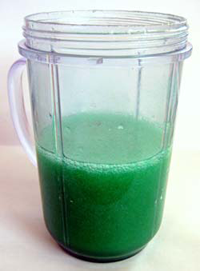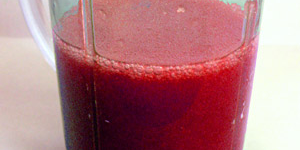Saved by the Clot
How does the human body "turn off" bleeding from an injury? Why do some people bleed too much? This October, a cool experiment lets you investigate blood coagulation!
By Kim Mullin
Don't Drink the Science
What you mix up doesn't have to be green, but this green combo (it's not a smoothie!) fits in great with Halloween spookiness. The mixture shown in the blender is part of the procedure from the "Blood Clotting to the Rescue: How to Stop Too Much Blood from Flowing" science project. Depending on what you add next, you might end up with little semisolid (gelatinous) balls. Pretty cool science, and a great way to explore coagulation!
What's the perfect accessory for a frightful Halloween? Fake blood, and plenty of it! Dripping, oozing, spurting—from vampires to gory masks, blood plays a starring role in the scarier side of Halloween. That makes October the right time to get kids interested in a sticky topic—blood coagulation!
Blood Coagulation Keeps Us Safe
We've all had minor cuts and scrapes that bleed, or even a bloody nose. Although it can seem like the bleeding lasts a long time, it does eventually stop. Why? Because it is unhealthy to lose a lot of blood, so as soon as we are injured, our bodies rush into action to form a clot.
Clots are made up of four components: platelets, clotting factors, fibrin, and blood cells. One after the other, these items stick together around the wound to plug it and stop the bleeding. This process is called coagulation. Most people's bodies coagulate blood naturally, but some people have a genetic disorder called hemophilia, and their blood does not coagulate easily. Because the flow of blood may not stop quickly, even minor injuries can be very dangerous for someone with hemophilia.
Coagulation Simulation
If you fell off a skateboard and skinned your knee, you would feel the pain and see blood flow from the scrape. Ouch! But it is tricky to really see blood coagulation in action because the components are so small. When that's the case, scientists sometimes make models to simulate what is happening.
You can make your own blood coagulation model at home! The "Blood Clotting to the Rescue: How to Stop Too Much Blood from Flowing" Project Idea shows you how to do it step-by-step. You'll use an eyedropper to introduce one liquid into another, and you'll end up with tiny little gelatinous spheres! You'll also see what happens when you introduce an anticoagulant into the mix. (Some people take anticoagulant medicine because their blood clots too much.)
As you experiment with your model, think about questions like these: What result would work best for plugging a hole in a blood vessel? What could scientists do to help someone who has a blood disorder like hemophilia?
Vampire or not, our blood is a fascinating topic!
Categories:
You Might Also Enjoy These Related Posts:
- Plastics and Earth Day - Science Projects
- Arduino Science Projects and Physical Computing
- 10+ Robotics Projects with the BlueBot Kit
- 5 STEM Activities with Marshmallow Peeps
- March Madness Basketball Science Projects: Sports Science Experiments
- Women in STEM! More than 60 Scientists and Engineers for Women's History Month
- Explore Artificial Intelligence and Machine Learning with Student AI Projects
- 10 Reasons to Do the Rubber Band Car Engineering Challenge











